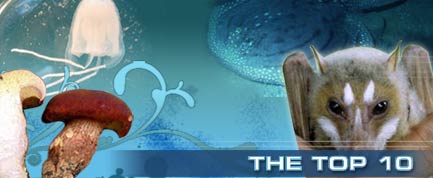Group Touts 10 Wild New Species

Thousands of new plant and animal species were discovered in 2007, though only 10 were bizarre enough, lethal enough or just plain cool enough to garner spots on a new Top-10 list.
Each year, the International Institute for Species Exploration (IISE) at Arizona State University issues the Top 10 New Species list, which spotlights flora and fauna described during the previous year, so in this case 2007.
The new list includes lethal animals like a box jellyfish (Malo kingi) — named after Robert King, who apparently died after he was stung by this species — and the Central Ranges Taipan (Oxyuranus temporalis), now thought to be one of the most venomous snakes in the world.
And a dragon millipede, whose shocking-pink exterior would put a 1980s fashionista to shame, gets a spot on the list. Rather than setting trends, the arthropod uses its gaudy coloration to alert predators of its toxicity.
Some species made it onto the list due to their modern monikers, including the Michelin Man, a succulent plant from Western Australia that resembles the rotund tire guy. Also on the list: an ornate sleeper ray from the east coast of South Africa that was named after the Electrolux vacuum cleaner brand due to the animal's ability to suck up prey in the water.
While scientists discover thousands of species each year, with an estimated 16,969 species considered new to science in 2006, plenty of plants and animals are waiting to be found. Scientists estimate 10 million or so species exist on Earth, with 1.8 million species described since Carl Linnaeus developed the modern system for naming plants and animals in the 18th century.
"Most people do not realize just how incomplete our knowledge of Earth's species is or the steady rate at which taxonomists are exploring that diversity," said Quentin Wheeler, an entomologist and director of IISE.
Get the world’s most fascinating discoveries delivered straight to your inbox.
The international committee was chaired by Janine Caira of the University of Connecticut, and included scientists from across the globe, including the United States, United Kingdom, South Africa, Spain and New Zealand.
- Top 10 New Species
- Greatest Mysteries: How Many Species Exist on Earth?
- Images: Endangered and Threatened Wildlife
Jeanna Bryner is managing editor of Scientific American. Previously she was editor in chief of Live Science and, prior to that, an editor at Scholastic's Science World magazine. Bryner has an English degree from Salisbury University, a master's degree in biogeochemistry and environmental sciences from the University of Maryland and a graduate science journalism degree from New York University. She has worked as a biologist in Florida, where she monitored wetlands and did field surveys for endangered species, including the gorgeous Florida Scrub Jay. She also received an ocean sciences journalism fellowship from the Woods Hole Oceanographic Institution. She is a firm believer that science is for everyone and that just about everything can be viewed through the lens of science.


